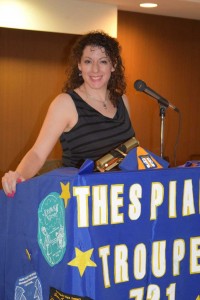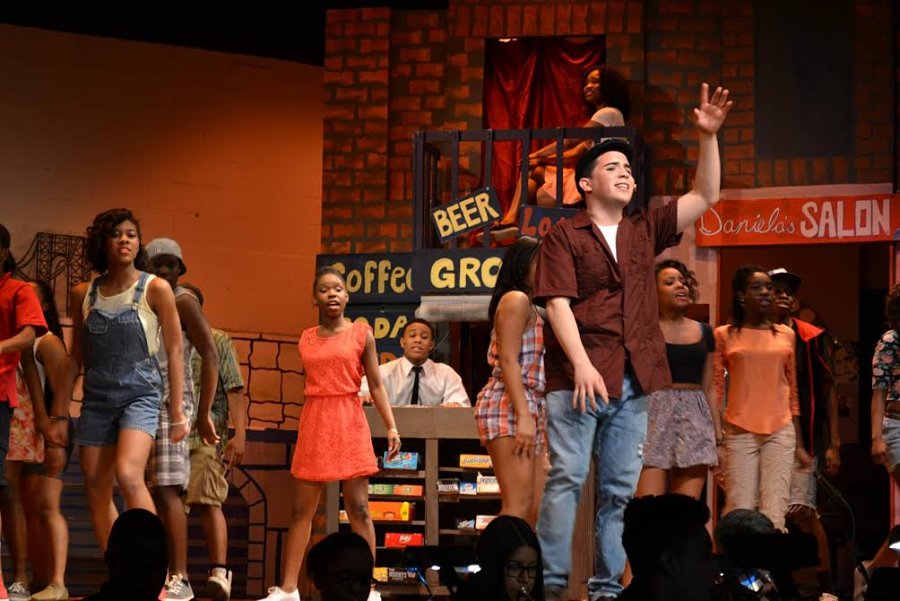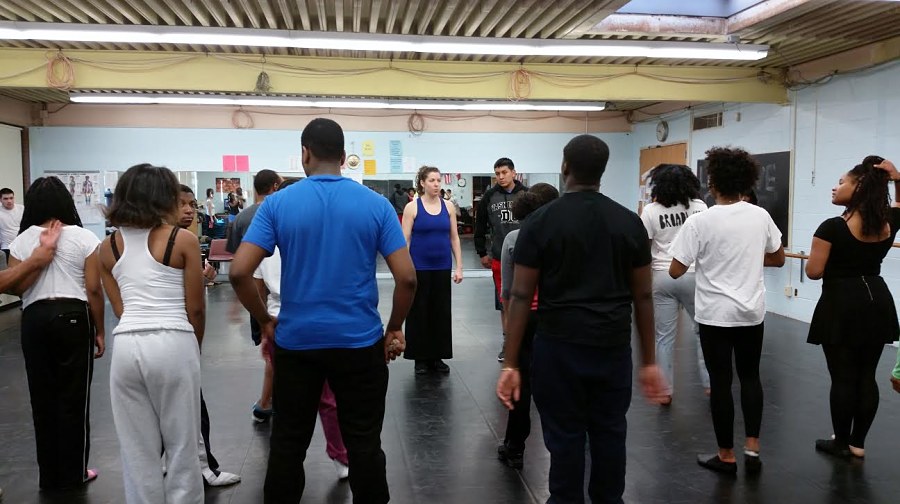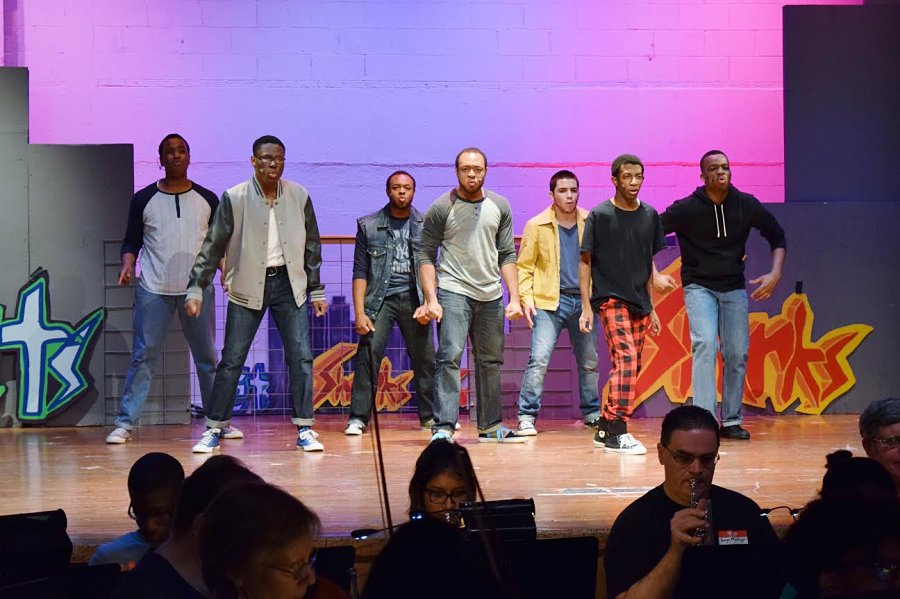SPRING VALLEY, N.Y: In a high school auditorium about an hour north of New York City, I’m watching choreography, blocking, lighting cues and set changes fitfully coming together. At the foot of the stage, Stacey Tirro stands, but rarely stands still—she marks through the dance steps along with her cast, gives lighting instructions into a microphone, and lunges toward every student she directs, as if she could pull what she wants out of them through sheer energy. She wears athletic gear—dance pants and a stretchy tank top—as the uniform of her daytime role of Dance Teacher, but it isn’t a formality: Before long she is up onstage, jumping and sliding along the ground to demonstrate how the counts come, reworking her adaptation of Jerome Robbins’s West Side Story choreography on the spot.
As she slips back off the lip of the stage and counts off “a-five, six, seven, eight” for the number to begin, seven teenage boys skulk around the stage, snapping their fingers and hunching their shoulders as Manuel Piedra, playing Riff, starts to sing. I’ve seen West Side Story before, but this is somewhere mid-act and I don’t have my bearings in the piece. It’s not until the Jets begin popping and exploding in staccato bursts—“Pow!” “Go!”—that I start to get that electric hum of recognition along my spine.
Then the boys sprint upstage and pivot to face the audience, and I feel it—oh, this!—as they come downstage, arms hung down, hunched over, and snap their fingers with a tuck jump in the most famous and beautiful bit of ferocious teenage-boy-gang choreography in all of musical theatre.
It feels like a miracle in several ways. To see seven fierce teenage boys, big, athletic seniors and wiry underclassmen, a full spectrum of brown shades of skin, catapulting themselves downstage in rehearsal sweats, full of intention—that is one kind of miracle. To see high schoolers a week out from performances 90 percent of the way to pulling off this difficult choreography feels like a kind of miracle, too.
But I’m here, back at my high school 15 years after I last performed on its stage, to witness something more precious, more endangered. Because in this high school, it is now some sort of miracle that, good or bad, hard or easy, any theatre production happens at all.
Last September, an episode of This American Life brought the story of the East Ramapo Central School District to a national audience. My high school, Spring Valley, is one of two in the district. I can’t remember all the euphemisms for a financially troubled, racially diverse school that I picked up when I was there: “rough,” certainly. “Disadvantaged,” perhaps, which seems more precise but is much less descriptive. We didn’t seem to have the things students had at “good” schools, including arts electives—I never got to take a creative writing class, for instance. The majority of the students were African-American and the children of Central American and Caribbean immigrants, but the district also encompassed a town or two of middle-class, mostly white families, including mine.
But the situation in my home district that warranted an hour-long examination on arguably the most famous public radio show in the country arose from another quirk of the school district boundaries: The East Ramapo Central School District encompasses the above-mentioned towns, as well as a Hasidic Jewish community. In the last decade, Hasidic representatives have won a majority of school board seats, and they have cut budgets and eliminated programs. Sure, budgets are being cut in school districts across the state, but the This American Life episode—titled “A Not-So-Simple Majority”—described the situation in East Ramapo as a feud, a war. The tensions I remembered from my time there had shifted from detente to the hum of impending explosion. Everyone seemed to want to assign blame. The schools and students were suffering.
Petitions and local newspaper op-eds began to scroll down my Facebook feed, as they’d been doing for the last few years, only moreso. And I started noticing in sharper focus the photos, videos and updates coming from Thespian Troupe 721.
Troupe 721 was founded at Spring Valley in 1946 as a chapter of the International Thespian Society, a national umbrella for high school theatre programs. I’d been a member of Troupe 721 in high school in late ’90s. We did a fall play and a spring musical, in sync with the seasonal cycles of thousands of high schools across the country. We painted plywood flats and pulled massive dimmer switches in a lighting booth untouched—in terms of either technology or fresh paint—since, we guessed, the ’60s.

Our director then had been a young woman—she seemed young even to me, then, when I was 15 and all adults were all old—named Stacey Tirro, a dancer and theatre educator who’d started directing and choreographing the school shows just a few years before my time. And in the time since Spring Valley’s recent troubles began, Tirro has filled my Facebook feed with dispatches that seemed incongruously and impossibly vibrant in spite of it all.
When I asked her recently about the the school board situation, she was either being very careful or very generous—“thoughtful” might be the best word for it. She referred to “public school families” and “non-public school families.” She said, “I feel like there’s probably more shades of gray than are represented in the media and in public. Everybody’s just hurting. And I would assume they’re hurting on the other side, too.”
At first it even seemed like she was disconnected from the bigger picture.
“When it comes to my program, I say, well, we haven’t been cut yet, so let’s get to work,” she said. “The politics in the district don’t really matter to what we’re doing at the moment.”
But she’s not simply keeping her head down and hoping it all blows over. She’s trying to get work done. “If funding gets cut, there’s nothing we can do about that. But I try to get the message across that no matter what is happening around us, it does not have to impact the work that we do—what happens in the studio and the work that we put out.”
This is the realm of a devoted and beloved teacher, a place where Buddha-like acceptance meets scarcity of resources. “There’s always something else around the corner,” Tirro says. “The bell’s gonna ring and you have to do this and you have to do that.
“That having been said, I wouldn’t want to teach anywhere else.”
If the school district is struggling and suffering so much, how is the theatre program flourishing? I thought this question would require a couple thousand words to answer, but now I think the answer requires only two: Stacey Tirro.
The students I talked to saw it. When I asked about their teacher, whom they all call Tirro, they always said, “She cares.” Elijah Fremont, a senior who played Tony in West Side Story, said, “It’s one thing when a teacher gives you advice. It’s another thing when a teacher gives you advice and then helps you get to wherever it is they advise you to go. Tirro won’t just tell you that you need to point your foot when you kick your…” Fremont paused to fish for the right word, shrugged, and said, laughing, “Whatever, I’m not even a dancer. But she will actually take the time to help you develop that skill or help you develop or reach your potential or anything. She’ll actually make action.”
They all recognize that she respects them, which impressed me—not just that they felt it, but that they could name it.
But these are not just words. Between the last bell and the start of rehearsal, some alchemy transforms these students into dedicated professionals. Tirro radiates both love and high expectations, and her student performers treat each other with the same sort of demanding respect. Said Ingrid Castor, co-dance captain, “Even if she’s yelling at us, even if we get on each other, you know it’s not because you’re a bad person, because you can’t dance, you can’t sing. It’s because they’re pushing you to reach what they know you can reach.” She had started out talking about Tirro but slipped to “us,” as if the boundaries between the two are too porous to distinguish.
Maybe that’s the real surprise here: not that a floundering school’s theatre program is flourishing, but that in a school dismissed by outsiders as “troubled” or “rough”—pick your euphemism—someone is acting as if excellence is the baseline. And in expecting it, she makes it true.
There is another ingredient, though. The last two years of productions at Spring Valley, Tirro and her students agree, have been special. There’s always an ebb and flow of student talent; when some promising kids become juniors and seniors, you end up with a few strong casts.
But Tirro’s rehearsal updates on Facebook started giving me chills last spring, when she was directing In the Heights. This was before This American Life, actually, and the amplification of national attention. This was just a high school putting on a musical; but with this high school and this musical, it felt like something more.

As a choreographer and a dancer herself, Tirro said she gravitates toward dance-centric musicals. “You tend to be attracted to the pieces you know, and the things that you’re good at,” she said. “When I finally had the courage to look at In the Heights as a serious contender, and listen to the music, I was like, ‘Holy crap, this is so far from my experience.’” Then she thought of her students: “This is so far from what I know….but so close to what they’re comfortable with.”
That comfort transmuted into a power that shone through the Facebook pictures I saw on my screen. There was an ownership implied in the way the young performers actors stood onstage, in the tilt of their hips or the expanse of their arms, that told me this show was different. When I was at Spring Valley, the student body was more than half students of color; today it’s 96 percent, and many are the children of immigrants or immigrants themselves. I felt a new level of gratitude to Lin-Manuel Miranda for writing the show, for creating a space for 30 kids to sing the lives of a community just a few miles to the south of their homes, singing stories very much like their own families’.
West Side Story has struck close to home, too. From the start, the cast connected to the musical’s teenage milieu. When I told Tirro how impressed I was with the sincerity and the cast’s lack of awkwardness with all the stylized language—I had never heard a “Cracko jacko!” sound so good—she laughed and said they basically got it right from the start. “They understood the purpose of it,” she said. Maybe no one is better suited than teens to understand the slipping, shifting landscape of nonsense slang.
But West Side Story resonated in Spring Valley in hard ways, too. Two-and-a-half weeks before the show opened, a Spring Valley junior stabbed another student at school; although, luckily, the Spring Valley student survived, the students and teachers were shaken, and the parallels with West Side Story—a feud escalates to a fight, a fight escalates to a stabbing—brought the musical, to which the students were already easily connecting, even closer to home. It went from “it happens” to “it happened here.”
Though as a director and choreographer, Tirro treats her cast with full adult respect, an educator’s worldview is still the engine of her work. When she told me about her response to the stabbing, just a week after the event, her concern for her cast and future audience was inextricable from concern for the students involved. She worked through the questions of how her students would feel performing the rumble and how an audience might react; the core of what troubled her was, as she put it, “What were the bad decisions that led to this, and what can we as a community do to protect kids—not necessarily from violence, but from being violent?”
We were in the dance studio, itself another miracle—it had been converted from two foreign-language classrooms about a decade ago, when Tirro’s dance program was beguiling students and before the district hit its toughest crunch. Mirrors line one wall and motivational posters reminding students to work hard fill every other available space. Tirro invited me to stand on the sprung floor—the real deal. This was where those rehearsal videos I’d been watching on Facebook were recorded. This was the haven she was holding up for her students.
Tirro hears it all the time: If it weren’t for Thespians, if it weren’t for dance class, I wouldn’t come to school. It’s not the sugar to get the medicine down; it’s something more vital. The stabbing is part of the same equation: “What can we as a community do to protect kids” was just a few breaths from, “How do you get those kids to arts programs? How do you get arts programs to those kids?”

Said Tirro, “I feel like I have to almost overcompensate for what society does to these kids. I feel like I have to undo—or try to undo—years and years and years of you suck you suck you suck.” Tirro has two daughters of her own, and she sees in them and in her students all the wounds of the world’s ways of telling them that they’re less-than. “The outside world tells them that, too, and the media, and all of those layers of society’s bullshit. You believe it. And so I feel like it’s part of my job to help them stop believing that.” Instead, she gets them to believe in a project and their part in that collaboration. “They don’t have to doubt everything. They can sometimes say, Why not?” She calls it a leap of faith.
Troupe 721 has dodged the budget cuts so far. There was a close call a few years ago, but a special act from the state government restored funding for a few school activities, like Thespians and Key Club. The only funding the troupe gets from the district is salaries for the professional staff: Tirro and a producer, a musical director and a technical director. Everything else is fundraised. (I have sent my own small checks to Spring Valley in response to Tirro’s Facebooked calls for aid.)
At schools across the country, theatre tends to be safer from budget fluctuations than other extracurricular activities. A 2012 study conducted by the Educational Theatre Association (parent organization of the International Thespian Society) and Utah State University on the state of high school theatre education found that the recession did not affect theatre programs as much as school budgets overall: 65 percent of school administrators reported budget cuts from 2009-2012, while only 32 percent of theatre teachers at those same schools reported that their budgets had been reduced. It’s hard to know, though, whether this this discrepancy means that schools are shielding their theatre programs from cuts, or if the programs are self-sustaining in ways that other extracurricular activities are not.
There is ticket revenue, for one. Unlike basically every other nonprofit theatre producer in the country, high school programs get a significant portion of their budget from ticket sales. This is how Troupe 721 makes most of its budget. For West Side Story, tickets were $10 in advance, $15 at the door; $10 for students, $5 for seniors. Tirro’s elder daughter staffed the table when I picked my tickets up.
West Side Story packed the nearly 600-seat auditorium, but it was also expensive, as Bernstein’s score necessitated the hiring of professional musicians. (Tirro’s husband, Chris, also played trumpet in the pit.) And earned income aside, the program still relies on a bedrock of funding from the district.
Not every school program has been as lucky as Tirro’s. Two years ago, elementary-school arts and music classes were eliminated. Tirro said, “That’s eventually going to come and bite us hard, because we won’t have any trained musicians from the time they’re in elementary school to handle complex music. That’s gonna be very bad in the long run, and that’s coming down the pike.” The last East Ramapo students to have music classes in elementary school are now in middle school.
Do the struggles with the school board impact the students and how they feel about school and what they do? “That’s hard to answer,” Tirro said. “There are such special interests being served by the school politics. We’re trying to shade the kids from that glaring light and to say, Okay, this is what we have—this is what we’re gonna do.
“And as long as we’re self-sustaining in that way, then it doesn’t matter how the board or the non-public school community looks at us or disregards us. This is for us. Yeah, the general morale in the district is not great, and it also comes with everything that’s coming out of the state and the evaluations, this big quagmire of bad feelings. Just depression.” She laughs a bit, not bitterly, but just because she is in this predicament; she loves her students and her work, and the situation sucks. “But in the school and our four walls, we just do what we do.”
Jaime Green was once associate literary manager at MCC Theater. She now teaches writing and writes essays about theatre, food, science and museums. She is at work on a book about living history museums.


